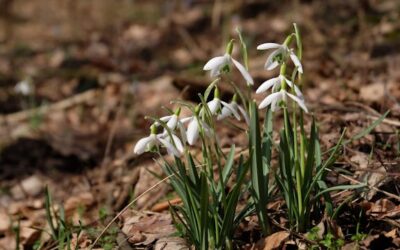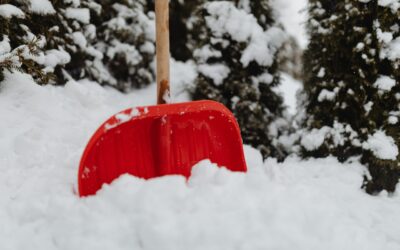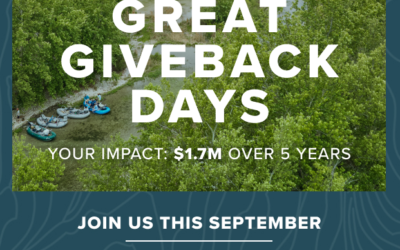CHECK IT OUT! Download our GGW Green Lawn Care Guidelines
If you’re ready to make “green” changes to your lifestyle, your yard is a great place to start. Greening our lives means taking a fresh look at old attitudes. Many of us consider our yards only as an extension of our living space. At the same time, we think of wildlife habitat as somewhere far away in a state park. But your yard can be a vital part of a healthy habitat for both your family and for wildlife, especially for birds and beneficial insects.
While we may be used to thinking of insects as pests, they are actually a vital part of a healthy ecosystem. And even in the suburbs, our ecosystem is vital to us. Insects — and by extension many different kinds of birds — are disappearing fast because of a lack of habitat, threatening the ecosystems we depend on. One of the greenest things you can do is to share your yard space with them by following the tips below.
Yard care has other big impacts on our environment. Conventional lawn care equipment causes air and noise pollution. Water gets wasted when we overwater our lawns and gardens. Runoff from yards stresses our stormwater management systems and dumps harmful fertilizers, pesticides and herbicides into our waterways. And, disposing of yard waste instead of composting it locally uses a great deal of energy to collect and transport it long distances.
The suggestions here can help you make your yard a “greener” space:
- Garden for Insects and Birds
- Remove Invasive Plants
- Use Greener Lawn Care Equipment and Practices
- Eliminate or Reduce Fertilizers, Pesticides, and Herbicides
- Reduce Gas-Powered Leaf Blower Use
- Use Water Carefully
- Reduce Runoff
- Compost
GARDEN FOR INSECTS AND BIRDS
- Replace non-natives with native plants with the help of the Little Garden Club of Wilmette’s Pocket Prairie Brochure 2017 and the Pocket Prairie Plant Guide 2017. Other great resources include “The Midwestern Native Garden” by local author Charlotte Adelman, and the very detailed Plants for Pollinators Guide.
- Explore Wilmette’s Centennial Prairie Garden at Hunter and Glenview Roads to see a large native plant installation. Also, the northwest corner of Gillson Park at Michigan and Lake Avenues contains extensive native plantings.
- Visit the Chicago Botanic Garden website to view native plant gardens and learn more.
- Turf grass and non-native, ornamental plants offer little food or habitat for native birds and beneficial insects. Many insects that are most important to our region feed on only the flowers, shrubs and trees that are native, meaning they evolved here. The monarch butterfly, which depends on just a few kinds of milkweed, is a perfect example. Planting true native plants in place of some turf grass or ornamental plants will bring back these wonderful bugs to your yard along with the beautiful songbirds that feed on them. Because native plants tend to grow long roots that reach deep into soil, adding them in your yard also has the benefit of reducing your need to use fertilizers and pesticides, improving water quality and reducing stormwater runoff. To learn more about the importance of adding native plants to your yard, consider reading Nature’s Best Hope by Douglas Tallamy.
^^back to list^^
REMOVE INVASIVE PLANTS
- Invasive plants are ones that evolved somewhere else in the world and compete with native plants. They don’t benefit insects and other wildlife. Two of the most problematic in our area are the shrub called buckthorn and a low-growing ground cover called lesser celandine.
- Avoid buying invasive trees and shrubs. Some popular varieties of shrubs, trees and perennial plants that you can buy spread quickly and can take over a landscape, crowding out beneficial native plants.. They can even be spread to forest preserves when their seeds are carried there by birds. If you’re in doubt about the trees you have, the Morton Arboretum website has advice about invasive trees and plants. To help you select the best plant for your situation, visit the Arboretum’s Tree and Plant Selection page.
^^back to list^^
USE GREENER LAWN CARE EQUIPMENT AND PRACTICES
- Use manual (i.e. rakes and push mowers), electric or alternative-fuel lawn equipment to greatly reduce emissions and pollution.
- Use a mulching mower and deposit grass clippings on your lawn. This will reduce your need for water and additional fertilizer. It also reduces yard “waste.” In the spring and fall, when the grass grows faster and there is too much to leave on the lawn, collect and compost the clippings.
- Keep your grass three to four inches long to withstand drought. Skip mowing on weeks when the weather is dry and grass growth has slowed. Longer grass has the added benefit of crowding out weeds.
- Try organic fertilizers and remedies when necessary. Don’t use fertilizers, chemicals or treatments if your lawn is healthy.
- Consider mulching and composting your leaves. Leaves make excellent insulation for your garden over the winter and add nutrients back to the beds. Shredded leaves (easily done by running your lawnmower over them) can be composted or used as winter mulch. Composting or mulching these leaves is not only good for your garden but reduces the cost of removing them.
- Learn more from SWANCC’s (Solid Waste Agency of Northern Cook County) Eco-Landscaping Guide and Chicago Botanic Garden’s Green Gardening Primer.
^^back to list^^
ELIMINATE OR REDUCE FERTILIZERS, PESTICIDES AND HERBICIDES
- Rethink the need for a perfect lawn. Turf grass does little to support wildlife, while spraying chemicals to maintain grass actually harms wildlife and may harm your family and pets.
- Discuss all yard treatments with your yard service company carefully. Be sure you know about and approve of all treatments.
- Leave your lawn clippings on your lawn. They provide natural fertilizer and reduce the need for chemical fertilizers.
- Eliminate or reduce your fertilizer use. Fertilizers wash off yards and gardens into sewers, contaminating waterways and the lake. This runoff is a threat to our aquatic environment and our drinking water. The average homeowner uses ten times more fertilizer per acre than the average farmer. For more information, click here.
- Eliminate or reduce your pesticide use. Pesticides threaten water supplies, aquatic organisms and non-targeted insects and birds.
- To reduce mosquito populations naturally, make sure there are no depressions or outdoor containers on your property that can hold standing water, which is where mosquito larvae develop. You can attract bats and birds to your property to eat mosquitoes. Also, certain herbs and flowering plants repel mosquitoes.
- Of the 32 pesticides routinely used by a major lawn service company:
- 13% are known or suspected endocrine disrupters
- 22% are known or suspected reproductive toxins
- 41% include ingredients that are banned or restricted in other countries
- 53% include possible carcinogens
- 100% negatively impact water supplies, aquatic organisms, and non-targeted insects.
GGW is proud to share with you a new fact sheet we’ve put together in partnership with Midwest Grows Green about backyard barrier treatments intended to reduce mosquitoes. Exercise caution when hiring these services. There are several reasons to avoid them and to rely instead on your local mosquito abatement district to control mosquitoes. For Wilmette and surrounding suburbs this is the North Shore Mosquito Abatement District.
Use this set of guidelines prepared by GGW to control mosquitoes in your yard.
- Eliminate or reduce your herbicide use. Allow a few weeds in your yard to help the planet. Your family and pets will benefit, too. Click here for more information. Also check out the Midwest Pesticide Action Center here.
^^back to list^^
REDUCE GAS-POWERED LEAF BLOWER USE
- Gas-powered leaf blowers are more harmful than many believe. They contribute significantly to both air and noise pollution levels. Leaf blowers also raise dust and other particles, and blowing leaves away reduces habitat for beneficial insects. Learn more about our leaf blower restrictions in Wilmette, and read this article from Popular Mechanics.
- Respect the restrictions in Wilmette on gas-powered leaf blowers from May 15th to September 30th. Learn more about the health and environmental hazards of leaf blowers.
- Make sure that your lawn service also obeys the law. Discuss the restrictions with them before you agree to annual service.
- Help the Village enforce the ordinance by handing out this leaf blower flyer for yard crews you see violating the law.
- In other towns, check your village regulations on gas-powered leaf blowers. Many towns have similar restrictions.
- Add your comments and experiences with leaf blowers to this local leaf blower website.
^^back to list^^
USE WATER CAREFULLY
- The overuse of water depletes our water resources and wastes energy, as that water is treated both before and after we use it.
- Approximately 40% of peak summer water usage is used for landscaping.
- Adding mulch to your garden and leaving grass clippings on the lawn retains soil moisture and improves soil quality, reducing your need to water.
- Soaker hoses and drip irrigation systems target watering and minimize the evaporation that occurs with sprinklers.
- If you do use a watering system, use a timing device to prevent overwatering and turn off the system when rainwater is adequate.
- Use rain barrels to collect rainwater that you can then use for your lawn and garden.
- Reduce the size of your lawn and substitute native plants. Native plants thrive in local climates without watering, fertilizers, or pesticides.
- Plant a rain garden to hold runoff water so that it can slowly penetrate the soil.
- Follow municipal watering restrictions to reduce water waste from evaporation during the hottest parts of the day. In Wilmette, lawn sprinkling is not permitted between the hours of 10 am and 4 pm Monday through Friday during the period of May 15th to September 15th.
- Visit the Chicago Botanic Garden Regenstein Fruit and Vegetable Garden or The Talking Farm to see examples of successful fruit and vegetable growing.
^^back to list^^
REDUCE RUNOFF
- Thoughtful landscaping practices can reduce stormwater runoff. This is important because it can minimize or eliminate basement flooding and the contamination of natural waterways from runoff. Reducing runoff can also help prevent CSO’s – combined sewer overflows that contaminate our lake. For more information, click here.
- Include bio-retention methods in your landscaping, such as basins, swales and rain gardens. For a description of bio-retention methods and plans for rain gardens and other retention sites, click here.
- Use rain barrels to collect water. Rain barrels store water for later use during the peak summer months and divert water away from storm drains, reducing runoff. Rain barrels are available at hardware stores and garden supply stores. Also, the Metropolitan Water Reclamation District of Greater Chicago sells up to two rain barrels to all residents living in their service area.
- Rain barrels can be placed on concrete blocks enabling you to fit a bucket under the spigot and improve the flow of water through a hose. Multiple barrels can be attached to each downspout. Don’t forget to collect rainwater from your garage, too.
- Install permeable pavers that permit water to seep through to the ground below and reduce runoff.
- Add native plants to your yard. Their extensive root systems help soak up excess rainwater.
^^back to list^^
COMPOST
Compost your yard waste and kitchen scraps to reduce the amount of organic waste in landfills. According to the U.S. EPA, in the United States, food is the single largest category of material placed in municipal landfills. In the oxygen free environment of a landfill, food emits methane–a powerful greenhouse gas–as it breaks down. Municipal solid waste landfills are the third-largest source of human-related methane emissions, accounting for approximately 14% of these emissions. Learn more from the USDA here: Why should we care about food waste? | USDA
- Composting reduces yard waste in landfills and creates excellent fertilizer, reducing the need for chemical fertilizers. Since food and yard waste in a compost pile break down in the presence of oxygen, they do not emit methane.
- Buy or build a compost bin. Composters are available in a wide variety of materials. They are available at hardware stores, lawn and garden shops and on-line. There are even indoor models. Have your lawn service deposit all lawn and garden waste into the bin. Check out these Triple Bin Compost Instructions.
- Compost natural, organic material such as grass clippings, leaves, fruit and vegetable scraps.
- Learn more about composting from SWANCC’s Eco-Landscaping Guide or the How To Compost Guide.
- If backyard composting isn’t for you, use the Village of Wilmette’s Curbside Food Scrap Composting program for yard waste and kitchen scraps. All you need to do is request a yard waste cart and you are ready to go! See the Village’s website for more information on the program here: Curbside Food Scrap Composting – Wilmette
- Another option is to use a collection service such as Collective Resource Compost. Service companies provide containers for the collection of kitchen scraps and typically offer weekly or bi-weekly pick-up. These options are also great solutions for condos and apartment buildings where many residents can take advantage of the collection service.
RESOURCES
- SWANCC’s Eco-Landscaping Guide
- Chicago Botanic Garden’s Green Gardening Primer
- How To Compost Guide
- SWANCC’s handouts for backyard composting
- Compost haulers and other resources: illinoiscomposts.org
- How to build a compost bin: farmhomestead.com/build-compost-bin
- Garden Tower: gardentowerproject.com



